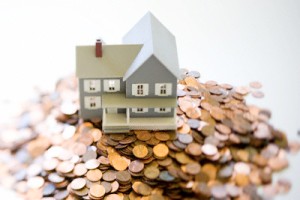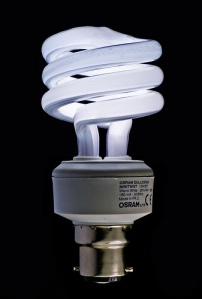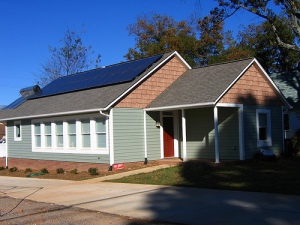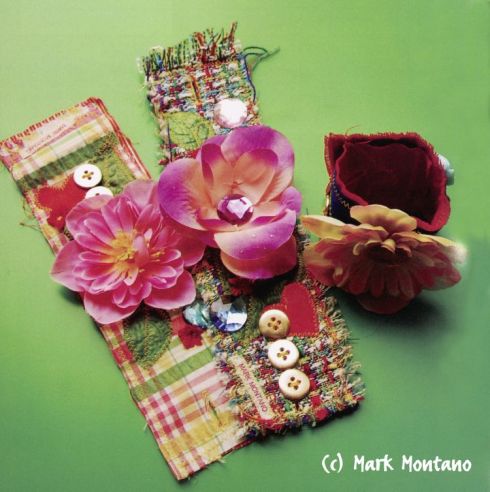You are currently browsing the category archive for the ‘Green’ category.
 Going green doesn’t have to cost a lot of green. We’ve done some research and found plenty of ways that you can go green around the house and not spend a lot. In fact, going green will often save you money, primarily in energy costs.
Going green doesn’t have to cost a lot of green. We’ve done some research and found plenty of ways that you can go green around the house and not spend a lot. In fact, going green will often save you money, primarily in energy costs.
Lower your water heater to 120 degrees Fahrenheit. Even a 10 degree reduction can save you 5 percent in energy costs and there’s no reason to have your hot water any higher.
Replace your incandescent bulbs with compact florescents.  According to the US Department of Energy:
According to the US Department of Energy:
“If every American home replaced one light bulb with an Energy Star qualified bulb, we would save enough energy to light more than three million homes for a year, more than $600 million in annual energy costs, and prevent greenhouse gases equivalent to the emissions of more than 800,000 cars.”
Seal the gaps. Doors and windows give away their air leaks and drafts because you can feel them. Two simple steps can help seal the leaks, lower your energy bills and keep you more comfortable. The first is weather stripping.
From ACME How-to:
Weather stripping should be installed along the sides and top of the door and a door sweep or similar device should be installed on the bottom of the door. Old weather stripping should be periodically replaced.
An all-purpose sealant will close the leaks around the outside of the doors and windows (the jambs, sills and moldings, particularly). This method works well for sealing around door and window frames, around plumbing fixtures and for small gaps. Using a low VOC adhesive like EcoGlue Extreme gives you instant grab and its completely water-based. It bonds to most any substrate instantly and can be painted after 24 hours.
Make sure your attic, basement and crawl spaces are well-insulated. These areas are notorious for letting heat and cooling escape.
Plant more trees on your property. Evergreen trees on the north and west sides of the house protect against winter winds and leafy trees on the south and west shade from the summer sun.
For more info:
Tips to Increase Your Home’s Energy Efficiency (Easy tips that anyone can do)
Green Home Tips (particularly helpful for historic homes, but lots of relevant tips)
Five Ways to Build Affordable, Energy Star Rated Houses (from BUILDER Magazine)

Zero Energy House in Hickory, North Carolina: http://www.flickr.com/photos/skrobotic/74815199/
Many families are spending money on smart remodeling and home improvements rather than embarking on major renovations or moving to a new home. What are the best projects to spend your time and money on?
- Projects that improve energy efficiency. Sealing windows, replacing siding or improving your home insulation will add value and reduce your energy bills, even in the short term. Often your local utility will provide rebates or incentives for projects like these, so check with them to find out more.
- Pared-back kitchen or bathroom remodels. According to the National Association of the Remodeling Industry, focusing on cosmetic improvements will cost you less, but still have a good return on the investment, even in the short run.
- Think green! According to a study by McGraw-Hill, people will pay a premium of up to $20,000 for a “green home.” Spend your remodeling dollars in ways that make your existing home more environmentally sustainable. Even the DIY products you use on project can make a difference. The Wall Street Journal offers several ideas for greening your home.
- Maintain and repair. Look for opportunities to make simple repairs to maintain your home and prevent expensive problems later. ServiceMagic recommends getting a home inspection. While not the most glamorous of tips, knowing if problems loom can give you an opportunity to head off disaster.
What other tips would you share? What projects are you taking on (or putting off) right now?
Our friend, Mark Montano, is hanging out at the Sundance Film Festival this weekend creating eco-chic and sustainably stylish projects and gifts. Mark is a featured guest at The Green Lodge, a special event at the Festival, where he’ll be crafting with celebrities.
Celebs like Olivia Newton John, Rhianna, Mariah Carey, Ashley Tisdale, Vanessa Hudgens and their High School Musicial 3 cast mates will create their own “urban corsage” from Mark’s The Big Ass Book of Crafts (page 140).

Because The Green Lodge is focused on recycling, upcycling and using eco-friendly resources, the Urban Corsage is a perfect fit. Mark will be also using EcoGlue with many of his craft projects for this event.
Stay tuned for more info, more projects and more Mark.
 Time to build your dream house. Do your plans include saving energy, living healthier, having a minimal impact on the environment and enjoying a floorplan that takes advantage of the setting? Leadership in Energy and Environmental Design or LEED certification can make sure that your dream home is all these things and more.
Time to build your dream house. Do your plans include saving energy, living healthier, having a minimal impact on the environment and enjoying a floorplan that takes advantage of the setting? Leadership in Energy and Environmental Design or LEED certification can make sure that your dream home is all these things and more.
A LEED certified home is a “green” home – it uses less energy, water and natural resources, creates less waste and is healthier for the people inside than a standard home. That all sounds great, right?
LEED certification is a program of the US Green Building Council. USGBC awards points to a project or structure in four areas:
- sustainable sites
- energy & atmosphere
- materials & resources
- innovation & design process
 After points are tallied, the project can be assigned a LEED rating of Certified, Silver, Gold or Platinum. A Platinum LEED certified building is about as green as you can get. See the point system here (PDF).
After points are tallied, the project can be assigned a LEED rating of Certified, Silver, Gold or Platinum. A Platinum LEED certified building is about as green as you can get. See the point system here (PDF).
The benefits for home owners and residents to living in a LEED certified building are really in three different categories: Savings, Space and Health
Savings
We’ve already told you that LEED certified home are more energy efficient. But how much more? The USGBC’s Web site “The Green Home Guide” offers this comparison.
That can translate into substantial savings.
In addition to lower energy bills, LEED buildings also use Energy Star building materials, so home owners can expect significant tax breaks and rebates.
Space
LEED buildings are designed intentionally to take advantage of light, space and orientation of the home on the site – everything from the foundation to the windows. For homeowners, the designs tend to be lighter and more open.
Health
LEED certified homes have a particular emphasis on indoor air quality. Indoor air pollution, which can be worse than outdoor air pollution can be detrimental to your health and has been linked to everything from chronic asthma to cancer.

Building materials are an important part of the indoor air quality of a home. LEED certified homes might use wheat-derived strawboard, natural linoleum like Marmoleum (see the list of ingredients here), as well as paint and adhesives with little or no volatile organic compounds (VOCs).
This is where EcoGlue Extreme comes in. Using this product as the adhesive in building a home can earn the builder a point toward their LEED rating.
LEED certified homes also have fewer problems with mold and mildew and the designs focus on both natural and mechanical ventilation systems to keep fresh air in and cycle stale air out.
So Why Not?
The biggest objection to pursuing green building or LEED certification is cost. According to the USGBC, if you choose experienced industry professionals, a LEED certified home should cost no more upfront than a standard home. And the net cost over the long run can be cheaper.
If you’re not building from scratch, you can also go green with your remodel. Take a look and we’ll come back to this topic in a later post.
Resouces:
Our new environmentally-friendly adhesives line, EcoGlue Green Solutions, just launched two new products. We’re excited!
Amazing EcoGlue we’ve discussed here before. We’re looking forward to an upcoming guest post about Amazing EcoGlue. We will keep you posted on that.

Now we’re also happy to introduce EcoGlue Extreme. Outstanding results on a variety of surfaces and safe to use indoors because it has no odor. An industrial strength adhesive with no odor!

And EcoGlue Premium Wood. This wood glue is water based with no animal derivatives. It outperforms most other white and wood glues in strength, flexibility, heat resistance, sandability and toughness. We’re particularly excited about this product. It’s being test right now by The Handy Guys of The Handy Guys Podcast and will be reviewed on an upcoming show.

I’m not sure why I’m drawn to these recycled material light projects, but I found another one via Design*Sponge and thought I’d share. If you want to see the other projects, go here.
Mason jar lights are a little shabby chic and very charming.
For the directions, visit Design*Sponge. Want to make your own eco-chic projects? Try Amazing Eco-Glue.
People are amazingly creative. This chandelier is made from plastic spoons! Created by studio_verissimo. What can you create today?


From the designer’s site:
This is a lamp made from plastic spoons used in the coffee which are going to the garbage daily by the thousands because they are only used once.The objective was with this waste to create a luxurious lamp.
Also, from Craftser, the yogurt cup lamp!


Want to make your own eco-chic projects? Try Amazing Eco-Glue.
 On this Earth Day, remember that going green does more than benefit the earth — it benefits your pocketbook by saving money on energy bills. Some of the following tips are inexpensive and easy, while others require an initial investment but pay for themselves in time.
On this Earth Day, remember that going green does more than benefit the earth — it benefits your pocketbook by saving money on energy bills. Some of the following tips are inexpensive and easy, while others require an initial investment but pay for themselves in time.
- Since older models require significantly more energy to run, consider replacing your air conditioner or furnace if they are more than 10 years old. Before you buy, look for Energy Star rated models which meet strict EPA and Department of Energy guidelines.
- Plant deciduous trees to shade the south side of your house. Deciduous trees will shade in the summer and lose their leaves in the winter to let more sun (and heat) into your house. For more landscaping tips visit HGTV and for more about planting trees visit American Forests.
- Reduce water consumption and lower the cost of heating water by repairing leaky fixtures and installing low flow shower heads, faucets and toilets.
- Make sure the walls and attic are well-insulated, adding more where needed.
- Prevent wasted heat or cooling by sealing leaky windows.
- Replace bulbs and lighting fixtures with energy-efficient fluorescent bulbs. These pay for themselves with the savings they provide.
- Recycling kitchen waste into garden compost is another great way to contribute to the health of the environment. It not only reduces the amount of garbage going into landfills, but makes for healthier plants, too. Learn how at HowtoCompost.org
Finally, look for green products to replace your everyday household items. Green cleaners, paper products and even DIY tools can be found at your local store. For DIY, we at Eclectic Products have developed an adhesive that is earth-friendly without sacrificing the strength. Amazing EcoGlue is an industrial-strength adhesive for the green-conscious DIYer. EcoGlue has less than one percent volatile organic compounds (VOCs) by weight, no animal derivatives and virtually no hazardous pollutants. Even the bottle and packaging are recyclable.
 A house becomes a home when we make it our place of renewal and family — a place where we unwind from our busy days and connect again with each other. We design interiors filled with the things we love to create a place of laughter, light and beauty.
A house becomes a home when we make it our place of renewal and family — a place where we unwind from our busy days and connect again with each other. We design interiors filled with the things we love to create a place of laughter, light and beauty.
But a home is more than a haven for us — it is a place that can have an impact our health and even the environment. More and more Americans are choosing building practices and using products that conserve energy and water and keep the air they breathe cleaner and healthier.
Organizations like the U.S. Green Building Council and the National Association of Home Builders know that the components in some materials used in building or remodeling your house can seriously affect your health and the environment around you —chemicals from carpets, adhesives and sealants, and paints and coatings, for example, are released into the air and your lungs. How do you know if your home is really a healthy home?
Ask your contractor what kinds of materials and products (such as caulks and adhesives) are used and what he does to make sure your home is environmentally safe and earth-friendly.
Investigate the level of “VOCs,” or Volatile Organic Compounds, in these items. In a 2002 bulletin, the Solvents Industry Group of the American Chemistry Council stated that “the solvents used in products such as coatings, adhesives and consumer products are generally classified as VOCs that can be emitted into the air after they perform their function.”
The building industry knows that solvents are an important component of a wide range of high performance products used in building and remodeling homes. It also knows that those products need to be as safe as possible. More and more manufacturers are stepping up by producing industrial “green products,” especially caulks, sealants and adhesives, which are high performance but environmentally safe for construction. You can ask that such products be used in the construction or remodeling of your home wherever possible.
You can also do your own research about what’s available.
- The Green Home Guide offers solutions from granite countertop sealers to wall paint and wood stains to water-wise bathroom choices.You can even”ask a pro.”
- The National Association of Home Builders has green home building guidelines available for download. “NAHB’s voluntary Model Green Home Building Guidelines are designed to be a tool kit for the individual builder looking to engage in green building practices and home builder associations (HBAs) looking to launch their own local green building programs.”
- Your Green Home is a Corvallis, Oregon store that also takes online orders for green supplies and building materials. Pretty good selection and reasonable shipping costs. Of course it’s important to consider the shipping when calculating your “greenness.” If you’re on the east coast, find a local supplier and save the environmental cost of freight.
- Want some inspiration? Check out the HGTV Green Dream Home. Seven basic sustainability areas were targeted during the building of HGTV’s Green Home 2008: innovation and design, location and linkages, sustainable site, water efficiency, energy and atmosphere, materials and resources, indoor environmental quality, awareness and education. Find out more here.
Have more resources you’d like to share? Leave them in the comments!
Looking for a green adhesive for making basic repairs around the home? Check out Amazing EcoGlue. This water-based adhesive is environmentally safe (it has less than 1 percent volatile organic compounds), with virtually no hazardous air pollutants and no animal derivatives. The bottle and packaging are recyclable, too.
![Reblog this post [with Zemanta]](https://i0.wp.com/img.zemanta.com/reblog_e.png)


